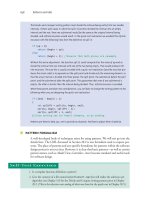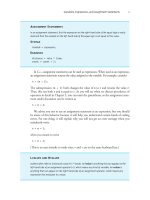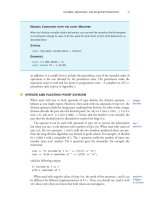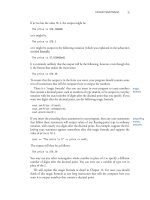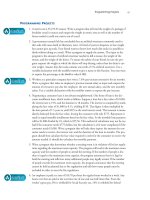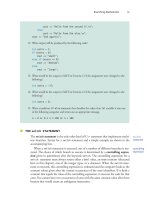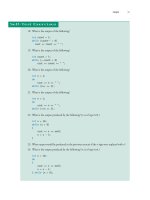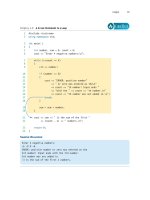Absolute C++ (4th Edition) part 1 potx
Bạn đang xem bản rút gọn của tài liệu. Xem và tải ngay bản đầy đủ của tài liệu tại đây (328.07 KB, 10 trang )
1
C++ Basics
1.1 INTRODUCTION TO C++ 2
Origins of the C++ Language 2
C++ and Object-Oriented Programming 3
The Character of C++ 3
C++ Terminology 4
A Sample C++ Program 4
1.2 VARIABLES, EXPRESSIONS, AND ASSIGNMENT
STATEMENTS 6
Identifiers 6
Variables 8
Assignment Statements 10
Pitfall: Uninitialized Variables 12
Tip: Use Meaningful Names 13
More Assignment Statements 13
Assignment Compatibility 14
Literals 15
Escape Sequences 17
Naming Constants 17
Arithmetic Operators and Expressions 19
Integer and Floating-Point Division 21
Pitfall: Division with Whole Numbers 22
Type Casting 23
Increment and Decrement Operators 25
Pitfall: Order of Evaluation 27
1.3 CONSOLE INPUT/OUTPUT 28
Output Using
cout
28
New Lines in Output 29
Tip: End Each Program with
\n
or
endl
30
Formatting for Numbers with a Decimal Point 30
Output with
cerr
32
Input Using
cin
32
Tip: Line Breaks in I/O 34
1.4 PROGRAM STYLE 35
Comments 35
1.5 LIBRARIES AND NAMESPACES 36
Libraries and
include
Directives 36
Namespaces 37
Pitfall: Problems with Library Names 38
CHAPTER SUMMARY 38
ANSWERS TO SELF-TEST EXERCISES 39
PROGRAMMING PROJECTS 41
01_CH01.fm Page 1 Wednesday, August 20, 2003 2:21 PM
1
C++ Basics
The Analytical Engine has no pretensions whatever to originate anything.
It can do whatever we know how to order it to perform. It can follow
analysis; but it has no power of anticipating any analytical relations or
truths. Its province is to assist us in making available what we are already
acquainted with.
Ada Augusta, Countess of Lovelace
INTRODUCTION
This chapter introduces the C++ language and gives enough detail to allow
you to handle simple programs involving expression, assignments, and con-
sole input/output (I/O). The details of assignment and expressions are simi-
lar to those of most other high-level languages. Every language has its own
console I/O syntax, so if you are not familiar with C++, that may look new
and different to you.
Introduction to C++
Language is the only instrument of science.
Samuel Johnson
This section gives an overview of the C++ programming language.
■
ORIGINS OF THE C++ LANGUAGE
The C++ programming languages can be thought of as the C programming
language with classes (and other modern features added). The C program-
ming language was developed by Dennis Ritchie of AT&T Bell Laboratories
in the 1970s. It was first used for writing and maintaining the UNIX operat-
ing system. (Up until that time, UNIX systems programs were written either
in assembly language or in a language called B, a language developed by Ken
Thompson, the originator of UNIX.) C is a general-purpose language that can
be used for writing any sort of program, but its success and popularity are
closely tied to the UNIX operating system. If you wanted to maintain your
UNIX system, you needed to use C. C and UNIX fit together so well that
soon not just systems programs but almost all commercial programs that ran
under UNIX were written in the C language. C became so popular that ver-
sions of the language were written for other popular operating systems; its use
1.1
01_CH01.fm Page 2 Wednesday, August 20, 2003 2:21 PM
Introduction to C++ 3
is thus not limited to computers that use UNIX. However, despite its popularity, C was
not without its shortcomings.
The C language is peculiar because it is a high-level language with many of the fea-
tures of a low-level language. C is somewhere in between the two extremes of a very
high-level language and a low-level language, and therein lies both its strengths and its
weaknesses. Like (low-level) assembly language, C language programs can directly
manipulate the computer’s memory. On the other hand, C has the features of a high-
level language, which makes it easier to read and write than assembly language. This
makes C an excellent choice for writing systems programs, but for other programs (and
in some sense even for systems programs) C is not as easy to understand as other lan-
guages; also, it does not have as many automatic checks as some other high-level lan-
guages.
To overcome these and other shortcomings of C, Bjarne Stroustrup of AT&T Bell
Laboratories developed C++ in the early 1980s. Stroustrup designed C++ to be a better
C. Most of C is a subset of C++, and so most C programs are also C++ programs. (The
reverse is not true; many C++ programs are definitely not C programs.) Unlike C, C++
has facilities for classes and so can be used for object-oriented programming.
■
C++ AND OBJECT-ORIENTED PROGRAMMING
Object-oriented programming (OOP) is a currently popular and powerful program-
ming technique. The main characteristics of OOP are encapsulation, inheritance, and
polymorphism. Encapsulation is a form of information hiding or abstraction. Inherit-
ance has to do with writing reusable code. Polymorphism refers to a way that a single
name can have multiple meanings in the context of inheritance. Having made those
statements, we must admit that they will hold little meaning for readers who have not
heard of OOP before. However, we will describe all these terms in detail later in this
book. C++ accommodates OOP by providing classes, a kind of data type combining
both data and algorithms. C++ is not what some authorities would call a “pure OOP
language.” C++ tempers its OOP features with concerns for efficiency and what some
might call “practicality.” This combination has made C++ currently the most widely
used OOP language, although not all of its usage strictly follows the OOP philosophy.
■
THE CHARACTER OF C++
C++ has classes that allow it to be used as an object-oriented language. It allows for
overloading of functions and operators. (All these terms will be explained eventually, so
do not be concerned if you do not fully understand some terms.) C++’s connection to
the C language gives it a more traditional look than newer object-oriented languages,
yet it has more powerful abstraction mechanisms than many other currently popular
languages. C++ has a template facility that allows for full and direct implementation of
algorithm abstraction. C++ templates allow you to code using parameters for types.
The newest C++ standard, and most C++ compilers, allow multiple namespaces to
accommodate more reuse of class and function names. The exception handling
01_CH01.fm Page 3 Wednesday, August 20, 2003 2:21 PM
4 C++ Basics
facilities in C++ are similar to what you would find in other programming languages.
Memory management in C++ is similar to that in C. The programmer must allocate
his or her own memory and handle his or her own garbage collection. Most compilers
will allow you to do C-style memory management in C++, since C is essentially a sub-
set of C++. However, C++ also has its own syntax for a C++ style of memory manage-
ment, and you are advised to use the C++ style of memory management when coding
in C++. This book uses only the C++ style of memory management.
■
C++ TERMINOLOGY
All procedure-like entities are called
functions
in C++. Things that are called
procedures
,
methods
,
functions
, or
subprograms
in other languages are all called
functions
in C++. As
we will see in the next subsection, a C++
program
is basically just a function called
main
; when you run a program, the run-time system automatically invokes the function
named
main
. Other C++ terminology is pretty much the same as most other program-
ming languages, and in any case, will be explained when each concept is introduced.
■
A SAMPLE C++ PROGRAM
Display 1.1 contains a simple C++ program and two possible screen displays that might
be generated when a user runs the program. A C++ program is really a function defi-
nition for a function named
main
. When the program is run, the function named
main
is invoked. The body of the function
main
is enclosed in braces,
{}
. When the program
is run, the statements in the braces are executed.
The following two lines set up things so that the libraries with console input and
output facilities are available to the program. The details concerning these two lines
and related topics are covered in Section 1.3 and in Chapters 9, 11, and 12.
#include <iostream>
using namespace std;
The following line says that
main
is a function with no parameters that returns an
int
(integer) value:
int main( )
Some compilers will allow you to omit the
int
or replace it with
void
, which indicates
a function that does not return a value. However, the above form is the most univer-
sally accepted way to start the
main
function of a C++ program.
The program ends when the following statement is executed:
return 0;
This statement ends the invocation of the function
main
and returns 0 as the function’s
value. According to the ANSI/ISO C++ standard, this statement is not required, but
many compilers still require it. Chapter 3 covers all these details about C++ functions.
functions
program
int main()
return 0;
01_CH01.fm Page 4 Wednesday, August 20, 2003 2:21 PM
Introduction to C++ 5
Variable declarations in C++ are similar to what they are in other programming lan-
guages. The following line from Display 1.1 declares the variable
numberOfLanguages
:
int numberOfLanguages;
The type
int
is one of the C++ types for whole numbers (integers).
Display 1.1 A Sample C++ Program
1 #include <iostream>
2 using namespace std;
3 int main( )
4 {
5 int numberOfLanguages;
6 cout << "Hello reader.\n"
7 << "Welcome to C++.\n";
8 cout << "How many programming languages have you used? ";
9 cin >> numberOfLanguages;
10 if (numberOfLanguages < 1)
11 cout << "Read the preface. You may prefer\n"
12 << "a more elementary book by the same author.\n";
13 else
14 cout << "Enjoy the book.\n";
15 return 0;
16 }
S
AMPLE
D
IALOGUE
1
Hello reader.
Welcome to C++.
How many programming languages have you used? 0
Read the preface. You may prefer
a more elementary book by the same author.
S
AMPLE
D
IALOGUE
2
Hello reader.
Welcome to C++.
How many programming languages have you used? 1
Enjoy the book
User types in 0 on the keyboard.
User types in
1 on the keyboard.
01_CH01.fm Page 5 Wednesday, August 20, 2003 2:21 PM
6 C++ Basics
If you have not programmed in C++ before, then the use of
cin
and
cout
for con-
sole I/O is likely to be new to you. That topic is covered a little later in this chapter, but
the general idea can be observed in this sample program. For example, consider the fol-
lowing two lines from Display 1.1:
cout << "How many programming languages have you used? ";
cin >> numberOfLanguages;
The first line outputs the text within the quotation marks to the screen. The second
line reads in a number that the user enters at the keyboard and sets the value of the
variable
numberOfLanguages
to this number.
The lines
cout << "Read the preface. You may prefer\n"
<< "a more elementary book by the same author.\n";
output two strings instead of just one string. The details are explained in Section 1.3
later in this chapter, but this brief introduction will be enough to allow you to under-
stand the simple use of
cin
and
cout
in the examples that precede Section 1.3. The
symbolism
\n
is the newline character, which instructs the computer to start a new line
of output.
Although you may not yet be certain of the exact details of how to write such state-
ments, you can probably guess the meaning of the
if-else
statement. The details will
be explained in the next chapter.
(By the way, if you have not had at least some experience with some programming
languages, you should read the preface to see if you might not prefer the more elemen-
tary book discussed in this program. You need not have had any experience with C++
to read this book, but some minimal programming experience is strongly suggested.)
Variables, Expressions, and Assignment
Statements
Once a person has understood the way variables are used in pro-
gramming, he has understood the quintessence of programming.
E. W. Dijkstra,
Notes on Structured Programming
Variables, expressions, and assignments in C++ are similar to those in most other general-
purpose languages.
■
IDENTIFIERS
The name of a variable (or other item you might define in a program) is called an
iden-
tifier
. A C++ identifier must start with either a letter or the underscore symbol, and all
1.2
identifier
01_CH01.fm Page 6 Wednesday, August 20, 2003 2:21 PM
Variables, Expressions, and Assignment Statements 7
the rest of the characters must be letters, digits, or the underscore symbol. For example,
the following are all valid identifiers:
x x1 x_1 _abc ABC123z7 sum RATE count data2 bigBonus
All the above names are legal and would be accepted by the compiler, but the first five
are poor choices for identifiers because they are not descriptive of the identifier’s use.
None of the following are legal identifiers, and all would be rejected by the compiler:
12 3X %change data-1 myfirst.c PROG.CPP
The first three are not allowed because they do not start with a letter or an underscore.
The remaining three are not identifiers because they contain symbols other than letters,
digits, and the underscore symbol.
Although it is legal to start an identifier with an underscore, you should avoid doing
so, because identifiers starting with an underscore are informally reserved for system
identifiers and standard libraries.
C++ is a case-sensitive language; that is, it distinguishes between uppercase and
lowercase letters in the spelling of identifiers. Hence, the following are three distinct
identifiers and could be used to name three distinct variables:
rate RATE Rate
However, it is not a good idea to use two such variants in the same program, since that
might be confusing. Although it is not required by C++, variables are usually spelled
with their first letter in lowercase. The predefined identifiers, such as
main, cin, cout,
and so forth, must be spelled in all lowercase letters. The convention that is now
becoming universal in object-oriented programming is to spell variable names with a
mix of upper- and lowercase letters (and digits), to always start a variable name with a
lowercase letter, and to indicate “word” boundaries with an uppercase letter, as illus-
trated by the following variable names:
topSpeed, bankRate1, bankRate2, timeOfArrival
This convention is not as common in C++ as in some other object-oriented languages,
but is becoming more widely used and is a good convention to follow.
A C++ identifier can be of any length, although some compilers will ignore all char-
acters after some (large) specified number of initial characters.
I
DENTIFIERS
A C++ identifier must start with either a letter or the underscore symbol, and the remaining char-
acters must all be letters, digits, or the underscore symbol. C++ identifiers are case sensitive and
have no limit to their length.
case
sensitive
01_CH01.fm Page 7 Wednesday, August 20, 2003 2:21 PM
8 C++ Basics
There is a special class of identifiers, called keywords or reserved words, that have a
predefined meaning in C++ and cannot be used as names for variables or anything else.
In the code displays of this book keywords are shown in a different color. A complete
list of keywords is given in Appendix 1.
Some predefined words, such as
cin and cout, are not keywords. These predefined
words are not part of the core C++ language, and you are allowed to redefine them.
Although these predefined words are not keywords, they are defined in libraries
required by the C++ language standard. Needless to say, using a predefined identifier
for anything other than its standard meaning can be confusing and dangerous and thus
should be avoided. The safest and easiest practice is to treat all predefined identifiers as
if they were keywords.
■
VARIABLES
Every variable in a C++ program must be declared before it is used When you declare a
variable you are telling the compiler—and, ultimately, the computer—what kind of
data you will be storing in the variable. For example, the following are two definitions
that might occur in a C++ program:
int numberOfBeans;
double oneWeight, totalWeight;
The first defines the variable numberOfBeans so that it can hold a value of type int, that
is, a whole number. The name
int is an abbreviation for “integer.” The type int is one
of the types for whole numbers. The second definition declares
oneWeight and total-
Weight
to be variables of type double, which is one of the types for numbers with a
decimal point (known as floating-point numbers). As illustrated here, when there is
more than one variable in a definition, the variables are separated by commas. Also,
note that each definition ends with a semicolon.
Every variable must be declared before it is used; otherwise, variables may be
declared any place. Of course, they should always be declared in a location that makes
the program easier to read. Typically, variables are declared either just before they are
used or at the start of a block (indicated by an opening brace,
{ ). Any legal identifier,
other than a reserved word, may be used for a variable name.
1
C++ has basic types for characters, integers, and floating-point numbers (numbers
with a decimal point). Display 1.2 lists the basic C++ types. The commonly used type
1
C++ makes a distinction between declaring and defining an identifier. When an identifier is
declared, the name is introduced. When it is defined, storage for the named item is allocated.
For the kind of variables we discuss in this chapter, and for much more of the book, what we are
calling a variable declaration both declares the variable and defines the variable, that is, allocates
storage for the variable. Many authors blur the distinction between variable definition and vari-
able declaration, The difference between declaring and defining an identifier is more important
for other kinds of identifiers, which we will encounter in later chapters.
keyword or
reserved
word
declare
floating-point
number
01_CH01.fm Page 8 Wednesday, August 20, 2003 2:21 PM
Variables, Expressions, and Assignment Statements 9
for integers is int. The type char is the type for single characters. The type char can be
treated as an integer type, but we do not encourage you to do so. The commonly used
type for floating-point numbers is
double, and so you should use double for floating-
point numbers unless you have a specific reason to use one of the other floating-point
types. The type
bool (short for Boolean ) has the values true and false. It is not an
integer type, but to accommodate older code, you can convert back and forth between
bool and any of the integer types. In addition, the standard library named string pro-
vides the type
string, which is used for strings of characters. The programmer can
define types for arrays, classes, and pointers, all of which are discussed in later chapters
of this book.
Display 1.2 Simple Types
TYPE NAME MEMORY USED SIZE RANGE PRECISION
short
(also called
short int)
2 bytes -32,767 to 32,767 Not applicable
int
4 bytes -2,147,483,647 to
2,147,483,647
Not applicable
long
(also called
long int)
4 bytes -2,147,483,647 to
2,147,483,647
Not applicable
float
4 bytes approximately
10
-38
to 10
38
7 digits
double
8 bytes approximately
10
-308
to 10
308
15 digits
long double
10 bytes approximately
10
-4932
to 10
4932
19 digits
char
1 byte All ASCII characters
(Can also be used as an integer type,
although we do not recommend doing
so.)
Not applicable
bool
1 byte
true, false
Not applicable
The values listed here are only sample values to give you a general idea of how the types differ. The values
for any of these entries may be different on your system.
Precision
refers to the number of meaningful dig-
its, including digits in front of the decimal point. The ranges for the types
float, double, and long
double
are the ranges for positive numbers. Negative numbers have a similar range, but with a negative
sign in front of each number.
01_CH01.fm Page 9 Wednesday, August 20, 2003 2:21 PM
10 C++ Basics
Each of the integer types has an unsigned version that includes only nonnegative
values. These types are
unsigned short, unsigned int, and unsigned long. Their
ranges do not exactly correspond to the ranges of the positive values of the types
short,
int, and long, but are likely to be larger (since they use the same storage as their corre-
sponding types
short, int, or long, but need not remember a sign). You are unlikely to
need these types, but may run into them in specifications for predefined functions in
some of the C++ libraries, which we discuss in Chapter 3.
■
ASSIGNMENT STATEMENTS
The most direct way to change the value of a variable is to use an assignment state-
ment. In C++ the equal sign is used as the assignment operator. An assignment state-
ment always consists of a variable on the left-hand side of the equal sign and an
expression on the right-hand side. An assignment statement ends with a semicolon.
The expression on the right-hand side of the equal sign may be a variable, a number, or
a more complicated expression made up of variables, numbers, operators, and function
invocations. An assignment statement instructs the computer to evaluate (that is, to
compute the value of) the expression on the right-hand side of the equal sign and to set
the value of the variable on the left-hand side equal to the value of that expression. The
following are examples of C++ assignment statements:
totalWeight = oneWeight * numberOfBeans;
temperature = 98.6;
count = count + 2;
The first assignment statement sets the value of totalWeight equal to the number in
the variable
oneWeight multiplied by the number in numberOfBeans. (Multiplication is
expressed using the asterisk,
*, in C++.) The second assignment statement sets the value
of
temperature to 98.6. The third assignment statement increases the value of the vari-
able
count by 2.
V
ARIABLE
D
ECLARATIONS
All variables must be declared before they are used. The syntax for variable declarations is as fol-
lows.
S
YNTAX
Type_Name
Variable_Name_1
,
Variable_Name_2
,. . .;
E
XAMPLE
int count, numberOfDragons, numberOfTrolls;
double distance;
unsigned
assignment
statement
01_CH01.fm Page 10 Wednesday, August 20, 2003 2:21 PM
